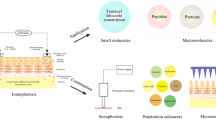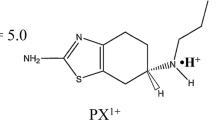Abstract
Purpose. The aim of this paper was to assess the feasibility of electrically enhanced transdermal delivery of alniditan, a novel 5 HT1D agonist for the treatment of migraine.
Methods. An in vitro study was first performed to optimize the different parameters affecting iontophoresis efficiency. The mechanism of alniditan permeation by iontophoresis was investigated. Finally, a phase I clinical trial was performed to assess systemic delivery of alniditan by iontophoresis.
Results. i) In vitro: The optimal conditions were found with a buffer like ethanolamine at a pH of 9.5, with Ag/AgCl electrodes and a direct current application. Alniditan permeation was enhanced when increasing the current density, the duration of current application and the drug concentration. Iontophoresis slightly increased drug quantities in stratum corneum compared to passive diffusion but it strongly increased alniditan quantities in viable skin, ii) The objective to deliver in vivo 0.5 mg of alniditan within less than 1 h was reached but an erythema was detected at the anode.
Conclusions. This study demonstrates the feasibility of iontophoretic delivery system for antimigraine compounds.
Similar content being viewed by others
REFERENCES
B. H. Sage and J. E. Riviere. Model systems iontophoresis-transport efficacity. Adv. Drug Del. Rev. 9:265–287 (1992).
B. H. Sage. Iontophoresis, in Encyclopedia of Pharmaceutical Technology. Swarbrick J., Boylan J. C. (Eds). vol. 8 (1993) pp 247–217.
S. M. Sims, W. I. Higuchi, and V. Srinivasan. Skin alteration and convective solvent flow effects during iontophoresis: I. Neutral solute transport across human skin. Int. J. Pharm. 69:109–121 (1991).
V. Préat and S. Thysman. Transdermal iontophoretic delivery of sufentanil. Int. J. Pharm. 96:189–196 (1993).
S. Thysman, C. Tasset, and V. Préat. Transdermal iontophoresis of fentanyl: delivery and mechanistic analysis. Int. J. Pharm. 101:105–113 (1994).
H. Schaefer and E. Lamaud. Standardization of experimental models. in Pharmacol. Skin. Schott, B, Shaefer, H. (Eds), vol. 1 (1987) pp 77–80.
P. Green, B. Shroot, F. Bernerd, W. R. Pilgrim, and R. H. Guy. In vitro and in vivo iontophoresis of a tripeptide across nude rat skin. J. Controlled Release 20:209–218 (1992).
A. Jadoul, C. Hanchard, S. Thysman, and V. Préat. Quantification and localization of fentanyl and TRH delivered by iontophoresis in the skin. Int. J. Pharm. 120:221–228 (1995).
A. K. Banga and Y. W. Chien. Iontophoretic delivery of drugs: fundamentals, developments and biomedical applications. J. Controlled Release. 7:1–24 (1988).
J. Nightingale, J. Sclafani, and T. Kurihara-Bergstrom. Effect of pH on the iontophoretic delivery of ionic compounds. Proceed. Intern. Symp. Control. Rel. Bioact. Mater. 17:431–432 (1990).
M. B. Delgado-Charro and R. Guy. Iontophoretic delivery of nafarelin across the skin. Int. J. Pharm. 117:165–172 (1995).
J. B. Phipps and J. R. Gyory. Transdermal ion migration. Adv. Drug Del. Rev. 9:137–176 (1992).
C. Cullander, G. Rao, and R. H. Guy. Why silver/silver chloride? Criteria for iontophoresis electrodes. in Prediction of Percutaneous Penetration, K. R. Brain and V. A. Walters (Eds), STS Publishing, vol. 3, 1993, pp. 381–390.
L. L. Wearley, J. C. Liu, and Y. W. Chien. Iontophoresis-facilitated transdermal delivery of verapamil. II. Factors affecting the reversibility of skin permeability. J. Controlled Release 9:231–242 (1989).
S. Thysman and V. Préat. In vivo iontophoresis of fentanyl and sufentanil in rats: pharmacokinetics and acute antinociceptive effects. Anesth. Anal. 77:61–66 (1993).
Author information
Authors and Affiliations
Rights and permissions
About this article
Cite this article
Jadoul, A., Mesens, J., Caers, W. et al. Transdermal Permeation of Alniditan by Iontophoresis: In Vitro Optimization and Human Pharmacokinetic Data. Pharm Res 13, 1348–1353 (1996). https://doi.org/10.1023/A:1016069816216
Issue Date:
DOI: https://doi.org/10.1023/A:1016069816216




